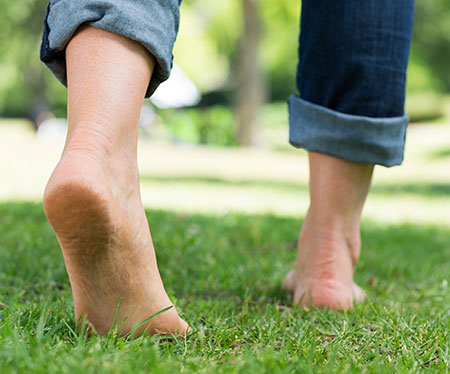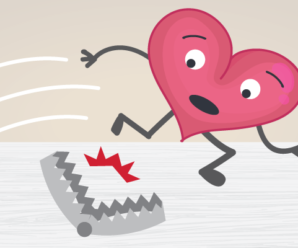Do you feel a sharp pain in your heel when you wake up in the morning and take that first step? Or do you have pain on the outside of your foot while walking? It’s not because you have to get out of bed for the day. It may be plantar fasciitis.

What is the pain in your heel?
Plantar fasciitis (fashee-EYE-tiss) is inflammation or swelling of fibrous band, or ligament, on the bottom of your foot that connects the bottom of the heel to the ball of the foot and supports the arch.
Kyle M. Dennison, D.P.M., Marshfield Clinic Health System podiatrist specializing in foot and ankle care, states he frequently encounters patients for plantar fasciitis and its associated heel pain.
“We see this condition as one of the most common causations of heel pain in our clinic” Dr. Dennison said. It’s common in people who spend prolonged periods standing on hard surfaces, athletes and those with unsupportive footwear. Inappropriate footwear can include flip flops, excessively worn shoes and shoes that have minimal arch support or cushioning.
People with tight calf muscles and Achilles tendons, are most common to develop plantar fasciitis. This tightness applies excessive force to the ligament and its attachment at the heel. Often there is a starting incident, such as a fast increase in activity like a hiking trip, starting a new exercise routine or running.
Signs of plantar fasciitis
The most common sign of plantar fasciitis is often a sharp pain in the bottom of the heel or arch, usually felt during the first few steps of the morning or the first steps after sitting for a period. You may also feel pain on the outside of your foot while walking.
“Sharp pain in the heel or arch early in the morning is the trademark of plantar fasciitis, “ Dr. Dennison said. “The tightness of the Achilles tendon on the foot, pulls the plantar fascia tightly which causes microtears in the ligament that are associated to the sharp and aching pain. As this stress continues to be applied to the ligament, it creates a vicious cycle of pain that flares up with activity and rest periods”
This pain can also happen when you sit for a long time, then get up and walk.
“It’s that sharp pain for the first few steps after getting up,” said Dr. Adina-Maria Anderson, podiatrist with Marshfield Clinic Health System. “The trauma to the fascia causes microtears, which can be attributed to tightness after prolonged rest. When stress is applied, the plantar fascia gets stretched and this can cause repetitive microtears in the tissue.”
How to treat pain on the outside of your foot
The primary objectives in treating plantar fasciitis are to reduce inflammation and prevent microtears in the plantar fascia. Conservative treatment often includes anti-inflammatory medications, icing of the affected area, stretching of the tight Achilles tendon and plantar fascia ligament, and the use of quality arch supportive insoles (orthotics) and good-quality shoe gear.
Treatment options for inflammation:
- icing the area
- over-the-counter topical anti-inflammatories (such as Bengay, Biofreeze, Voltaren gel, or Aspercreme)
- over-the-counter or prescription oral nonsteroidal anti-inflammatories (such as ibuprofen or Aleve),
- physical therapy modalities (such as ultrasound, iontophoresis, massage, Kinesio tape application and dry needling techniques).
While healing, you should temporarily cut back on physical activities to prevent microtears. Regularly performing calf-stretching exercises and wearing over-the-counter or custom orthotics can help. Custom inserts or orthotics mold to the natural contour of your foot, better support the arch and allow for more customization for any additional conditions such as arthritis, hammertoes or other foot conditions at the same time.
Additionally, wearing supportive shoes and avoiding walking barefoot, even at home, is important until the pain resolves. Some people wear splints at night to prevent the foot from relaxing and therefore allowing for natural tightening of the Achilles tendon and the plantar fascia. The night splints may help reduce the pain that patients experience with the first few steps in the morning.
“Thankfully studies show that 85% of plantar fasciitis cases will resolve with one or more of the above treatment modalities when utilized regularly,” Dr. Dennison said.
Treatment interventions for chronic plantar fasciitis
While plantar fasciitis should get better with treatment after several weeks, it may last for months to years. When more conservative methods fail, your podiatrist may recommend steroid injections that break up scar tissue and a potent anti-inflammatory.
Additionally, surgical interventions may be used to increase ligament flexibility. One option is Topaz Radiofrequency ablation procedure, which is an incisionless technique that uses radiofrequency to “dry needle” the plantar fascial ligament to increase flexibility and encourage healing. A more traditional surgical intervention is a plantar fasciotomy, a small incision to the side of the heel to a release the tightened and stiff area of the plantar fascia ligament. This manually increases flexibility and resolves the most chronic cases of heel pain.
For questions about your feet, talk to a Marshfield Clinic Health System provider.
Find a Podiatry provider Learn more about Podiatry
Related Shine365 articles
Plantar fibroma – 4 ways to treat without surgery






Leave a Reply